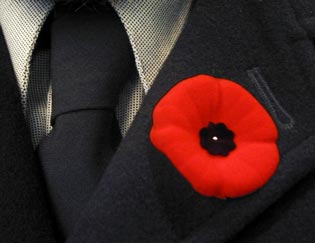 The distinguished red poppies that people so proudly don on their lapels serve as a universal symbol of remembrance for those who gave their lives during the many wars that Canada has fought.
The distinguished red poppies that people so proudly don on their lapels serve as a universal symbol of remembrance for those who gave their lives during the many wars that Canada has fought.
Whenever soldiers were preparing to take up arms, or were already in the midst of fighting, volunteers were working hard behind the scenes -- offering endless hours of their time and support in order to make the experience easier. The Salvation Army was one of those many groups that freely offered their services to the war effort.
"All of the other guys who have served, who are not here anymore, I have taken something from their lives," said Keith Inches, former army major and curator of the Saskatchewan Military Museum.
"Don't get me wrong, (the people that fought) deserve all the accolades they get, but there were a whole bunch of people that contributed a whole bunch of effort leading up to that, including guys that were too old to serve, and women who couldn't serve in the same respect.
"(People like the Salvation Army) get forgotten," he said.
On the reserves, overseas, or on the front lines, the "Sally Ann" provided their symbolic social services and charity to those who required it. Their presence was visible throughout the Boer War, and the First World War -- but their efforts were most often remembered during the Second World War.
In 1938, when the organization caught wind of the impending war, they approached the Canadian government in order to offer their experience in running hostels and canteens to the new set of troops preparing for battle.
"They all ran little canteens in rooms where you could get stationery, write a letter to your folks, somebody to talk to," said Inches. "It was a quiet place, you could play a game of cards, or just sit and reflect and have somebody to talk to. They also served coffee, tea and donuts."
There were several Salvation Army hostels stationed throughout the province, including camps in Dundurn, Saskatoon, Regina, Assiniboia, and Prince Albert. Many of the workers were women, with a majority of them being First World War veterans and others who were unable to fight.
According to Inches, workers at the Salvation Army hostels and canteens, were selfless, offering food, drink, support, and toiletries for free or at a minimal cost to troops whenever they were needed.
The selflessness of the Sally Ann has been revealed to Inches time and time again.
Whether it be a warming remark, or an added touch, veterans have told him many stories about how the organization played a role in their day. Inches recalled one man's story -- the veteran was a radio operator in a tank regiment and was waiting in formation to go into battle.
That's when he had his most memorable experience
with the organization.
"A truck pulls up, a lady gets out, and somebody says, 'What the hell are you doing here?' and she said, 'You guys are going into battle and we are going to give you tea.' One of the guys asked, 'Do you know where you are?' and she said, 'Of course I do and the Lord will look after me, and I am going to give you tea,'" said Inches, recalling the story. "Did she have to be there? Of course not. But the Salvation Army had good knowledge of where the troops were, and tried to be there for them -- and in this case, in a bit of danger to themselves."
As the curator of the Saskatchewan Military Museum, Inches said that there are many displays of wartime volunteers. He felt that the Salvation Army deserved one as well -- but he needed memorabilia in order to do it.
With a little bit of determination and a lot of luck, he was able to locate two important Salvation Army uniforms that were worn by volunteers during the Second World War -- the first being a dark blue soldier's uniform complete with a straw bonnet that he found in Brandon, Man., and the other being a dark blue female's uniform that he was able to unearth in Maple Creek.
"I had been trying to get a uniform for a museum display for some time. I kept talking to people, and didn't make any headway until this summer," he said. "(When I found them) I thought, 'Great, I've got two uniforms; I can make a display and tell a story,'" he said.
Alongside the uniforms are historical displays, stories, and photographs of the Salvation Army's involvement.
Trophies, medals, helmets and army fatigues scattered throughout the museum help to tell the stories of the province's troops. Each area garners a different reaction, and according to Inches, these volunteering displays seem to generate the most stories from veterans.
"When they get to that section and start looking, that's where the stories come out," said Inches. "It rings a bell, and they go, 'Oh yeah, I remember that.'"
by Shanna Schulhauser
Printed with permission from the Leader-Post, Regina